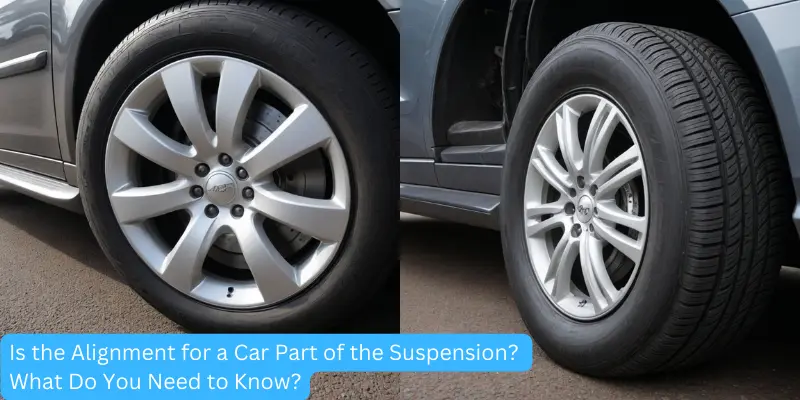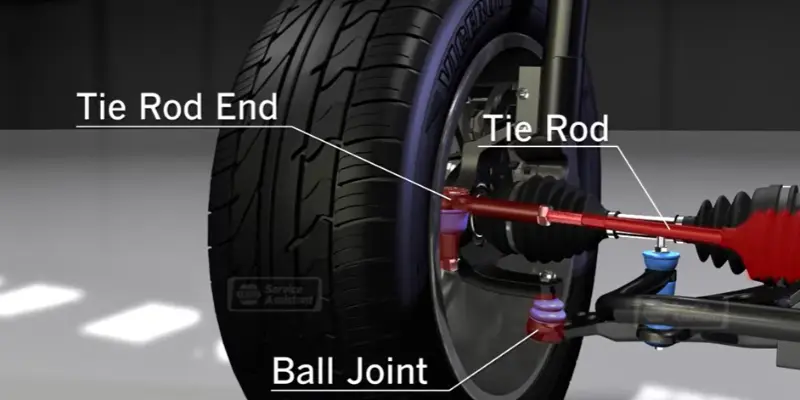Is the Alignment for a Car Part of the Suspension? What Do You Need to Know?
Updated: July 22, 2024
136
Ever feel like your car is playing tug-of-war with you, pulling slightly to one side as you drive down the road? That might be a sign your alignment needs attention. It sparks the question: is the alignment for a car part of the suspension? The answer is yes, but there’s more to the story!
This blog post will be your guide to alignment and suspension. We’ll explain car alignment, how it works in conjunction with your suspension system, and why both are crucial for a safe and smooth ride. So buckle up and get ready to learn how these two systems work together to keep your car happy and on the straight and narrow.
Understanding Car Suspension Alignment
Your car’s suspension system is like the body’s shock absorbers. It helps manage ride quality and vehicle handling by absorbing bumps and ensuring your tires stay in contact with the road. Think of it as the cushion that makes your drive smoother and more comfortable. The system includes parts like the springs, shock absorbers, and control arms.

What is Car Alignment?
Car alignment is the process of adjusting the angles of your car’s wheels to ensure they are set to the manufacturer’s specifications. Proper alignment ensures that your vehicle drives straight and handles correctly. If you’ve ever felt your car pulling to one side or noticed uneven tyre wear, it might be time to check your alignment.
The Connection Between Car Alignment and Suspension
So, is alignment part of the suspension system? Not exactly. While alignment and suspension are closely related, they are different components. Alignment refers to the angle adjustments of your wheels, while the suspension system consists of all the elements that support the vehicle’s weight and help it handle well. However, the condition of your suspension system can impact your alignment and vice versa.
“Many people mistakenly think wheel alignment and suspension are separate issues. In reality, alignment is a key component of the suspension system, directly affecting how the vehicle handles and rides. Ensuring your alignment is accurate can save you from costly repairs down the road.”Lisa M., Car Maintenance Expert
How Alignment Issues Affect Your Car?
When your alignment is off, your car might not drive straight, or you could experience uneven tyre wear. Misalignment can lead to poor handling and reduced fuel efficiency. It’s like driving with a crooked steering wheel – you might still get where you’re going, but it’s not going to be smooth.
Signs You Need an Alignment Check
Here are some signs that indicate you might need an alignment check:
| Symptoms |
|---|
|
Is The Alignment For A Car Part Of The Suspension?
The condition of the suspension system can impact alignment. For example, worn-out suspension parts can lead to misalignment. If your suspension system isn’t functioning properly, it can cause alignment problems and affect your vehicle’s handling and safety.
| Component | Function | Impact on Alignment |
|---|---|---|
| Springs & Struts | Absorb bumps and maintain ride height | Worn springs or struts can cause uneven tire wear and misalignment. |
| Ball Joints & Tie Rods | Connect steering components and allow wheels to turn | Damaged ball joints or tie rods can lead to loose steering and improper wheel angles. |
| Control Arms | Maintain wheel position and control movement | Bent or misaligned control arms can throw off wheel alignment. |
Maintaining Your Suspension System Of Vehicle With Respect To Alignment
Proper maintenance of your suspension system is essential to ensure it performs well and doesn’t affect your alignment. Regular inspections and timely repairs can prevent issues and prolong the life of your suspension components.
| Maintenance Step | Why It’s Important | Benefit for Alignment |
|---|---|---|
| Regular Inspections | Worn parts can cause misalignment. | Maintains optimal tyre contact with the road for proper alignment. |
| Proper Tire Inflation | Uneven pressure affects handling and tire wear. | Uneven pressure affects handling and tyre wear. |
| Avoiding Road Hazards | Potholes and bumps can damage suspension components. | Uneven pressure affects handling and tyre wear. |
| Scheduled Alignments | Alignment can shift over time. | Early detection prevents uneven tyre wear and extends tyre life. |
Expert Role for Car Alignment Related to Suspension
| Role of Professional Services |
|---|
|
DIY Alignment vs. Professional Alignment
Certainly! Here’s a comparison table between DIY Alignment and Professional Alignment:
| Aspect | DIY Alignment | Professional Alignment |
|---|---|---|
| Cost | Lower, minimal expense (tools and equipment) | Higher includes labor and service fees |
| Skill Level Required | Higher includes labor and service fees | Performed by trained technicians |
| Accuracy | May be less accurate; depends on technique | Highly accurate with specialized equipment |
| Equipment | Basic to intermediate requires learning | Advanced alignment machines and tools |
| Time | Longer; depends on individual skill and experience | Faster; performed efficiently by professionals |
| Convenience | Can be done at home; flexible timing | Requires scheduling and visiting a service center |
| Complex Issues | Difficult to diagnose and correct | Equipped to handle complex suspension issues |
| Warranty | May be less accurate; depends on the technique | Often comes with a warranty for the alignment work |
| Safety | Risk of incorrect alignment affecting vehicle safety | Ensures proper alignment for vehicle safety |
| Tools Maintenance | There is no warranty; repair costs may be higher if issues persist | Professional tools are maintained regularly by the shop |
Costs and Benefits of Proper Alignment Affecting Car Suspension
Investing in proper alignment might seem costly, but it pays off in the long run. Proper alignment improves your car’s handling, enhances safety, and reduces tire wear. It’s a small price to pay for peace of mind and a smoother driving experience.

“Understanding the relationship between wheel alignment and suspension is essential for maintaining your vehicle. Alignment adjustments are necessary to ensure that your suspension components work together efficiently, enhancing your vehicle’s overall performance and safety.”Michael S., Automotive Service Manager
Tips for Long-Lasting Suspension and Alignment
To keep your suspension system and alignment in top shape:
- Regularly inspect your suspension system: Look for signs of wear and tear.
- Avoid potholes and rough roads: They can damage your suspension and affect alignment.
- Get your alignment checked regularly: Follow the manufacturer’s recommendations for maintenance.
Conclusion
So, while car alignment isn’t technically part of the suspension system, it’s closely related. Proper alignment ensures that your suspension system performs optimally and contributes to a smoother, safer driving experience. By understanding the connection between alignment and suspension, you can better maintain your vehicle and address any issues that arise.
FAQs
How often should I get my car’s alignment checked?
It’s generally recommended to get your alignment checked every 6,000 to 12,000 miles or as specified in your vehicle’s owner’s manual.
What are the signs of a bad suspension system?
Signs include a rough ride, excessive bouncing, uneven tyre wear, or clunking noises when driving over bumps.
Is it necessary to align all four wheels?
While some vehicles only require alignment of the front wheels, others may need all four wheels aligned for optimal performance.
Can I drive with a bad alignment?
Driving with bad alignment is not recommended, as it can affect handling, and safety and cause further damage to your tyres and suspension system.
Please Write Your Comments